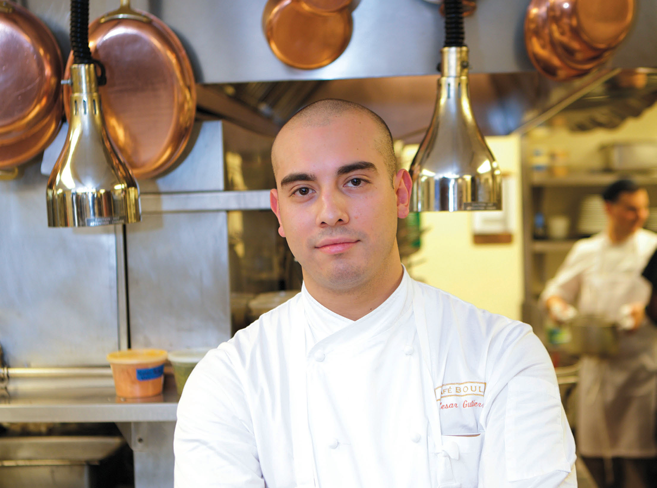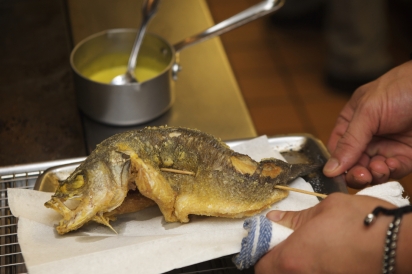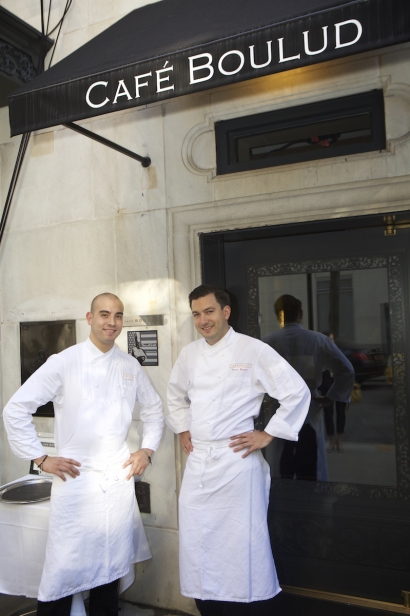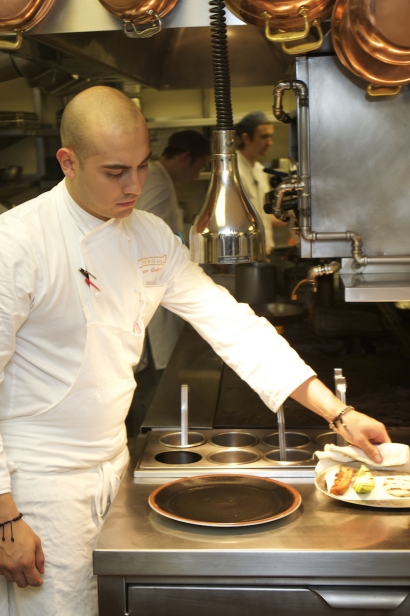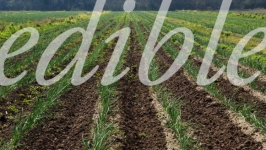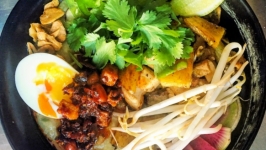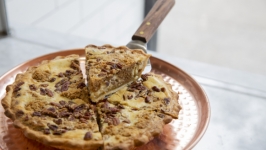Street to Kitchen: From Cartagena to Cafe Boulud
New York City in the 1990s was—well, not for the faint of heart. With its crime-laden streets and drug-ridden alleys, few then could hardly imagine paying $10 for a schmear of avocado on toast. Navigating the dark side of New York had its challenges. César Gutierrez, a Colombian-born Jackson Heights resident, was no different. The executive sous chef of the Michelin starred Café Boulud had arrived to this country by way of Mexico at the age of 4. After a common parental threat of stop carrying on with the wrong crowd and start-focusing-on-your-studies-or you’ll-be-out on- the-street, Gutierrez took it to heart, just not in the way his parents meant it. By the time he turned 12, he was living alone on the streets of Queens, relying on the care of vagrants for shelter and food. His parents were understandably anguished—an often-used admonition taken too stubbornly to heart.
Several years of illicit living finally got Gutierrez arrested and was the wake-up call he needed. He began working on his GED while attending cake-decorating classes near his home and realized he enjoyed working with food. A job at the local Burger King led to training at the School of Cooperative Technical Education, under the mentorship of Edwin Serna, who Gutierrez credits as “having started it all” for him. Gutierrez went on to compete in prestigious culinary events and to work in a handful of notable kitchens, namely D.O.M. (widely considered among the world’s best restaurants) under the guidance of Alex Atala, known for elevating indigenous ingredients from the Amazon.
I caught up with Gutierrez, now in his late 20s, one afternoon last summer. He was fresh from a trip to Colombia and buoyed by the success of presenting a Colombian menu at Café Boulud. His deep, soft voice and gentle mannerisms belie his story. Following is an excerpt from our conversation:
Claudia Sanchez: You just got back from a trip to Cartagena, Cali and Buenaventura. Where did you eat?
Cesar Gutierrez: I was trying to go local. I was asking all the taxi drivers where do they go. And one thing a lot of people told me was this fish shack: Kiosko El Bony. It’s so good. It’s this fish shack on the beach that gets so busy. It’s been there since 1973 or something like that. He used to box, and after he stopped boxing he set up a little shack. He’s from Cartagena. It turned out to be very popular. Their cazuela de mariscos … [Gutierrez interrupts himself to elaborate on the dish] A cazuela de mariscos is a seafood stew served in a black earthenware, which I brought back with me so we can use them here. I went to this huge market probably the size of three Costcos put together: Mercado de Bazurto. There’s no order, no system. You can find everything: sneakers, clothing, kitchen supplies, food. You can have lunch there. The produce is so good, so fresh. It’s not for everybody—it’s dirty, but I enjoy that stuff. And if you go, you got to wear some boots or sneakers ’cause if it rains, it can be muddy. It was great.
CS: Aside from the fish shack, where else did you eat?
CG: Inside the Old City, we went to La Cevicheria. It was so good. They did a ceviche with limón, limón amarillo, soy sauce. They use conch, mussels, octopus, shrimp—so much seafood—onions. It was one of the best ceviches I had there. I didn’t want to go to the fancy restaurants. I want to taste Cartagena; I want to taste Colombia and one night I was, “All right let’s go to one of the fancier restaurants.” I wasn’t disappointed, but I wasn’t … it wasn’t anything spectacular. We said, “We got to stick to the street food. We got to stick to where the taxi drivers tell us.”
CS: What are some ways that you would like to change the Colombian menu that you presented?
CG: Little adjustments. The arroz con coco that I make here—I use coconut milk and grated coconut. Theirs is more brown; this one is white. They get the coconut and they grate it. Then they make their own coconut milk from the grated coconut: They chop it and add water and then rub it against a stone so that it makes its own milk and put it into a towel and squeeze out all that milk. The flavor is incredible and then you get that pulp and purée it a little bit and then fold that into the rice and that’s what makes it brown, so that’s one thing I wanted to tweak.
CS: It was an amazing achievement to present a Colombian menu at a Michelin-starred restaurant. What was the origin of that?
CG: At Café Boulud we have four menus: La Tradition, Les Saisons, Les Marchés and Le Voyage. For Le Voyage, we explore the culture, the cuisine, break down what that country is about, its history, its influences. I was a little skeptical at first about the idea because Colombian food is ... To really elevate it, I needed to put some thought into it. It was very humbling to be able to show my roots. My nationality. You know, Colombian people are very proud. We are very proud of Colombia.
CS: You took some of Café Boulud’s team out to Queens to explore Colombian food. What were some of the places you visited?
CG: Between 79th and Northern Boulevard to maybe 88th, that whole strip of Northern Boulevard, there’s a huge Colombian influence. There’s a spot called La Perrada de Chalo. It has amazing hot dogs, Colombian-style hot dogs. There’s the bun, the wiener, pineapple sauce, mora (blackberry) sauce, a special sauce—which you know is just ketchup and mayo—then they make a garlic aioli and then they get salted potato chips and crumble them. Oh, and cheese, all on top. The trick to eating this dog is, you don’t take it out of the container. You unpackage it, fold it back and eat it right in the container. If you take it out, everything falls out. You lost out. Two stores down, there’s Los Cholados. You find cholados in Cali or in Buenaventura because it’s very hot and humid. A cholado is basically shaved ice. You can find it on the streets in Cali. They put all kinds of fruits: watermelon, grapes, lulo. The fruits over there are amazing. The fruit guy can be over there (pointing towards the far corner of the room) and you can smell it over here. It isn’t a cluster of smells. You can smell the banana. You can smell the lulo. You can smell the strawberries. You can smell it all. One late night, we took them to the Arepa Lady. She only sells shish kebabs, chorizos on a stick, with potatoes and two arepas: the white ones with cheese, and then the arepa de choclo, which is the sweet one and it’s much larger and it’s thin and there’s cheese and a lot of butter. They fold it over and pish! It’s amazing. The little restaurant that the children run … has many more arepas: choclo, rellenas (stuffed) with a whole bunch of meat or cheese, add the garlic sauce, and the special sauce. It’s great.
Gutierrez has set the bar high for himself and dreams of one day participating in the prestigious Bocuse D’or competition. The food presented on the Le Voyage menu and any of the other nights he is in the kitchen clearly reflects his passion, creativity and undeniable talent, only to be savored more deeply knowing his remarkable story.
Local Taste: Columbia
La Perrada de Chalo | @laperradadechalo
El Paisa Cafe | @elpaisabar
MiraCali Bakery
El Palacio de los Cholados | @ricocholados
César Gutierrez | @cesegutierrez
Café Boulud | @cafebouludny
School of Cooperative Technical Education
D.O.M.
Alex Atala | @alexatala
La Cevicheria | @lacevicheriacartagena
Mercado de Bazurto
Bocuse D’or


